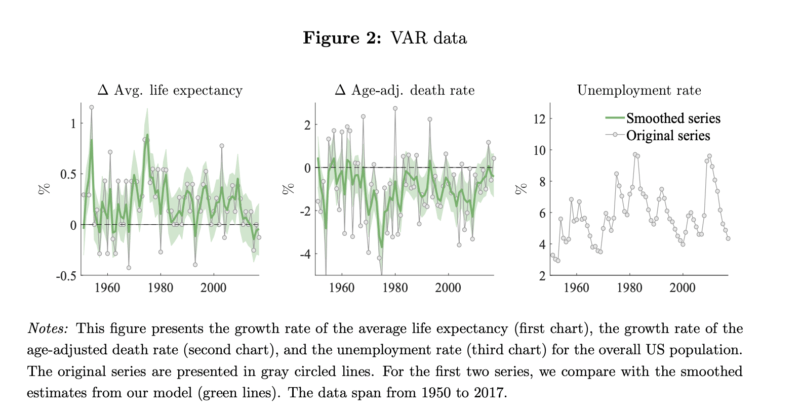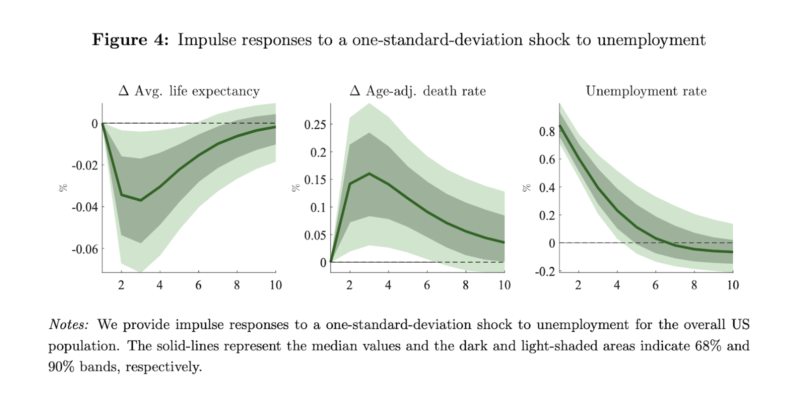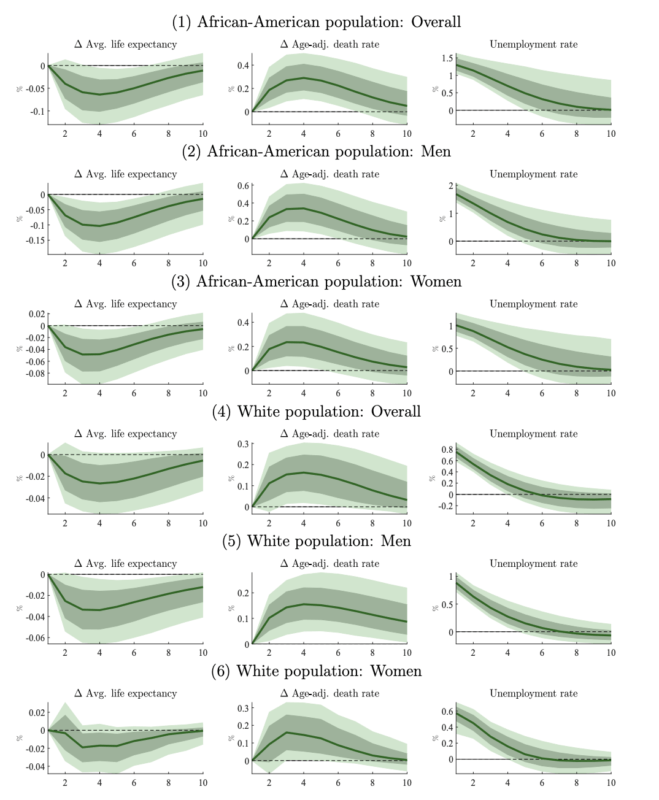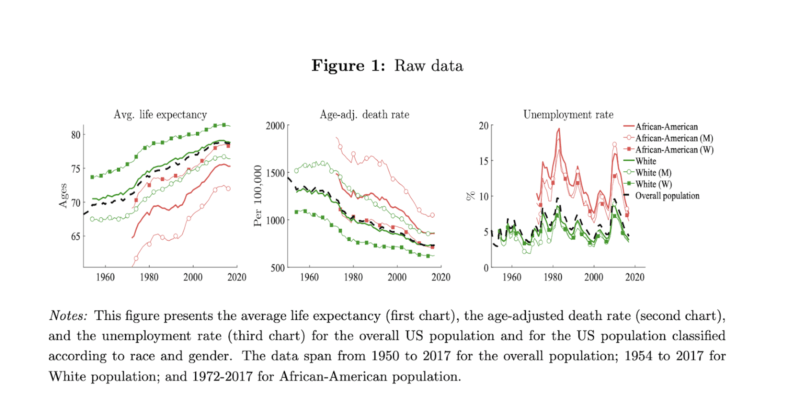
A new working paper published by the National Bureau of Economic Research gives a stark prediction that the economic damage brought about by lockdowns will lead to a significant increase in excess deaths for the long-term future. The authors of the study, a team of three researchers at Duke, John Hopkins, and Harvard, assert in their study that although they believe lockdown policies have saved lives, policymakers must be conscious of the long-term damage unemployment will have on public health. Rather than solely focusing on preventing deaths caused by Covid-19, we must also be cognizant of the deaths that will be caused by the economic damage of Covid-19 and lockdowns. There is much-documented discussion about the immediate tradeoffs of lockdowns from short-term economic devastation, to mental health problems, and drug overdoses. The authors explain the significance of their study on long-term damage when they write,
“Overall, the economic literature has extensively analyzed the short-run trade-off between economic activity and the containment of the pandemic. We emphasize that an equally important long-run trade-off exists. It is worth clarifying that with this claim, we do not want to suggest that policymakers should refrain from ordering lockdowns, as necessary lifesaving measures, but rather that, if they decide to do so, they should provide alongside enhanced health and economic support for the most vulnerable portions of the population.”
The aforementioned economic support is necessary because contrary to the prevailing narrative, a bad economy kills too. Although many would be quick to dismiss the catastrophic economic damage that has been done to the country as a sort of inconvenience (like Dr. Fauci) the authors contend that this damage will also lead to excess deaths in the long term. They write,
“We estimate the size of the COVID-19-related unemployment to be between 2 and 5 times larger than the typical unemployment shock, depending on race/gender, resulting in a 3.0% increase in mortality rate and a 0.5% drop in life expectancy over the next 15 years for the overall American population. We also predict that the shock will disproportionately affect African-Americans and women, over a short horizon, while white men might suffer large consequences over longer horizons. These figures translate in a staggering 0.89 million additional deaths over the next 15 years.”
This of course is just an estimate as there are a variety of factors that could shift this statistic, such as the fact that the true unemployment rate is likely far higher as many have simply given up on searching for a job. Although it is well-established that unemployment has a variety of immediate lethal consequences such as an increase in suicides and drug overdoses, the authors note that stressors associated with unemployment lead to shortened life expectancies and higher death rates years down the line.
The Data
The authors pool data on life expectancy, age-adjusted death rates, and unemployment rates from the CDC and the Bureau of Labor Statistics. They then inputted those numbers into a vector autoregression (VAR), which is a time series model that tracks the relationship of multiple variables. Provided below is the raw data featured in the study. The data is disaggregated to demonstrate the differences between demographics that are affected disproportionately by unemployment.

The above VAR demonstrates the relationship between the three variables: life expectancy, age-adjusted death rates, and unemployment rate over time from 1950-2017. Congruent with the authors’ thesis, life expectancy decreases and the death rate increases for years following a spike in unemployment. Furthermore, the authors explain the immediate increase in life expectancy at the onset of an unemployment spike when they write
“On impact, unemployment can lead to a reduction in mortality as deaths due to work-related causes or motor vehicle accidents declined, but over time economic distress takes a toll on human well-being. We consider this an interesting direction for future research.”
The data shows that there is a clear relationship between spikes in unemployment and an increase in mortality rates within the coming years, likely due to the various negative side effects associated with unemployment. The study provides disaggregated graphs showing individual trends for various demographics. They note that African-Americans and women tend to experience more extreme shocks in unemployment as well as more severe long-term health consequences.

Figure 4 is regarded as one of the most important graphs by the authors. That is because it shows the direct relationship between a drop in the unemployment rate and average life expectancy as well as death rates. The unemployment rate on the far right is shown spiking and then dropping off through the years. The two graphs to the left show that life expectancy and death rates continue to be affected years after the unemployment spike. They reach their peak severity about three years after the unemployment spike and don’t return to pre-spike levels for over ten years. In other words, life expectancies can be suppressed and death rates are higher for over two decades following a spike in unemployment.

Provided above is the disaggregated data to show the disproportionate effects an employment shock will have on various demographics. In particular, African-Americans and women will be hit hardest.
Potential Variables
It is worth noting that the study was conducted with data that is likely an imperfect representation of reality as all models are. The authors note that it is entirely possible that a swift or slow economic recovery may play a sizable role in the overall effects on future mortality. They also note that changing political and social circumstances may also affect the speed of economic recovery as well as the performance of the healthcare sector. Other important variables that could cause more severe outcomes are the disruptions to the healthcare sector during the pandemic, apprehension to seeking healthcare because of a fear of infection, and the massive loss of employer-provided healthcare. Finally, the authors note that this is the first recession with the Affordable Care Act in place, which may have an effect on an individual’s ability to access healthcare while unemployed.
What Does This All Mean
The study itself is quite numbers-dense and full of equations, but the message is clear. Unemployment is a real public health issue that if left unmitigated will lead to excess deaths in the future. The bulk of excess deaths do not occur suddenly but years in the future and they don’t return to normal for up to 20 years down the line. It is important that policymakers see past the fantasy that economic turmoil is simply a necessary inconvenience in a pandemic. That lockdowns are simply a necessary evil that are needed to stop Covid-19 and can do so without any serious repercussions at all. Whether you support more or less government intervention to address Covid-19, it is important to understand that economic turmoil has serious consequences and also harms public health.
Regardless of your position on lockdowns, addressing the economic damage these policies have created is just as important to preventing excess death as containing the virus. Failing to heed this lesson will simply be fighting one disease by creating another.



0 Comments